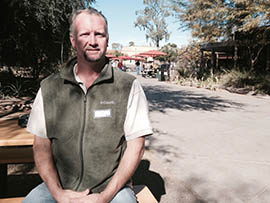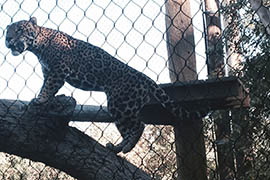- Slug: BC-CNS-ASU-Zoo Partnership,475
- Sidebar: Zoo conservation.
- Photos available (thumbnails, captions below)
By DIANGELEA MILLAR
Cronkite News Service
PHOENIX – A spotted jaguar crawls on a tree trunk, tail swinging as it looks through the fence at the Phoenix Zoo, waiting to be fed.
“He sees something that he wants,” Jan Schipper says.
Schipper has studied these jungle cats in Costa Rica in an effort to possibly save the endangered species. Now he’s taking his years of conservation research and applying it at the Phoenix Zoo.
His job as a conservation research fellow is funded by a new partnership between the zoo and Arizona State University’s School of Life Sciences. For three years he will continue his research while bringing in ASU students to help study conservation biology.
“My goal is to build a bridge between ASU and the zoo,” Schipper said. “I want to build new tools for conservation.”
For Schipper that means he will have students study animal behavior and talk to zoo visitors to raise awareness.
One animal he wants to study is the Calamian deer, which is only found on one island of the Philippines. These deer have faced recent danger from hunters after Super Typhoon Haiyan hit that nation in 2013.
Ideally, he would bring ASU students with him to study mating patterns within the indigenous populations to see how successful reintroducing captive Calamian deer could be.
He will split his time between the zoo, ASU and his field work as he continues to find new ways to help animals facing population threats.
“I haven’t quite figured out where my center will be,” he said.
The partnership also includes Ben Minteer, a School of Life Sciences professor and sustainability scholar who was named ASU’s Arizona Zoological Society Chair.
Minteer will work on a multi-year project that focuses on science ethics and the history of zoo conservation to figure out how zoos can help conserve species and engage the public.
“What can a zoo be in the future?” he said. “These aren’t just entertainment institutions.”
Minteer said he wants to bring educators, biologists and the public together to explore zoo conservation. He will be working on creating public panels and events that will “create a new thinking community.”
Ruth Allard, the Phoenix Zoo’s executive vice president for conservation and visitor experiences, said the partnership is still evolving and is important because the zoo is a privately funded nonprofit organization.
“It’s too early to say for certain what will come of those conversations, but we are enthusiastic about the potential for collaborations in the classroom, on Zoo grounds and in the field,” she said in an email.
She said the collaboration between the two institutions will foster more conversations that can result in long-term solutions for conservation problems, a sentiment Schipper shares.
“This is a beginning of a long-term relationship,” he said.
^___=
Zoo conservation:
The Phoenix Zoo’s efforts to help conserve species include:
• Black-footed ferret: This carnivore is one of the most endangered animals in North America. It was thought to be extinct twice until a small population was found in Wyoming. The zoo helps breed black-footed ferrets that are released at sites including Aubrey Valley in northern Arizona.
• Chiricahua leopard frog: These Arizona amphibians face high mortality rates in the wild, so the zoo breeds them for release as older tadpoles, ensuring that more of them survive.
• Arabian oryx: The zoo helped breed these animals, which used to range throughout the Middle East until hunters came in. The zoo helped Jordan and other countries in the region reintroduce the species.
^___=

Jan Schipper is a new conservation fellow at the Phoenix Zoo through a partnership funded by the zoo and Arizona State University. (Cronkite News Service Photo by DiAngelea Millar)

A jaguar kept by the Phoenix Zoo. Schipper’s conservation research is on jaguars in Costa Rica. (Cronkite News Service Photo by DiAngelea Millar)